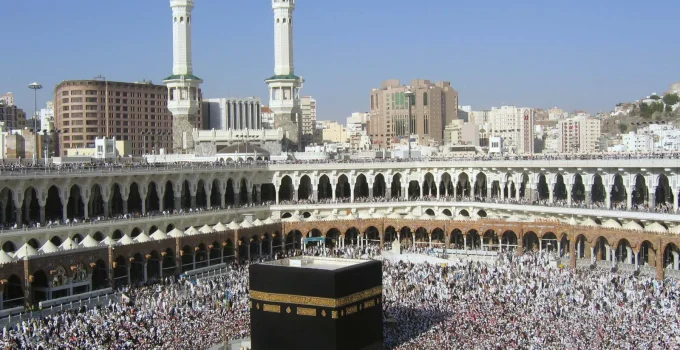Masjid al-Haram, also known as the Grand Mosque, is the largest and one of the most revered mosques in the world. Located in the holy city of Mecca, Saudi Arabia, it is the epicenter of the Islamic faith and spirituality. This sacred mosque surrounds the Kaaba, the holiest site in Islam, and is the focal point of the Hajj pilgrimage, one of the Five Pillars of Islam that every Muslim is required to perform at least once in their lifetime, if they are physically and financially able.
Contents
Historical Background Masjid al-Haram

The origins of Masjid al-Haram are deeply rooted in Islamic tradition. The Kaaba, a cube-shaped structure at the center of the mosque, is believed to have been built by the Prophet Ibrahim (Abraham) and his son Ismail (Ishmael) as a house of monotheistic worship. The significance of the Kaaba predates Islam, and it has been a sacred site for various religious traditions throughout history.
According to Islamic belief, the foundations of the Kaaba were laid by Prophet Adam, and the structure was later rebuilt by Ibrahim and Ismail on divine command. Over the centuries, the Kaaba and the mosque surrounding it have undergone numerous renovations and expansions to accommodate the growing number of worshippers.
The first substantial expansion of Masjid al-Haram occurred during the reign of the second Caliph, Umar ibn al-Khattab, who ordered the enlargement of the mosque to accommodate the increasing number of pilgrims. Subsequent Islamic rulers, including the Umayyads, Abbasids, and Ottomans, contributed to the expansion and beautification of the mosque.
Architectural Significance
Masjid al-Haram is not only a spiritual center but also an architectural marvel. The mosque covers an area of 356,800 square meters (3,841,000 square feet) and can accommodate over two million worshippers during the Hajj season. Its most striking feature is the Kaaba, which stands at the center of the mosque. The Kaaba is draped in a black silk and gold curtain known as the Kiswah, which is replaced annually during the Hajj.
The mosque is an amalgamation of various architectural styles, reflecting the contributions of different Islamic empires over the centuries. The mosque is characterized by its numerous minarets, domes, and large open courtyards. The most prominent feature of the mosque’s architecture is its minarets, which stand tall as symbols of Islamic presence and call the faithful to prayer. As of today, the mosque has nine minarets, with plans for further expansion.
One of the most significant architectural projects in recent history is the ongoing expansion of Masjid al-Haram, initiated by the Saudi government to accommodate the growing number of pilgrims. The expansion includes new prayer halls, additional minarets, and the development of surrounding infrastructure to ensure a comfortable and safe pilgrimage experience for millions of Muslims each year.
Spiritual Importance

Masjid al-Haram holds unparalleled spiritual significance for Muslims around the world. It is the qibla, the direction that Muslims face during their daily prayers, no matter where they are in the world. This connection to the Kaaba and Masjid al-Haram serves as a unifying factor for the global Muslim community.
The rituals of Hajj and Umrah, two pilgrimages performed by Muslims, revolve around Masjid al-Haram. Hajj, which takes place annually during the Islamic month of Dhu al-Hijjah, involves several rituals performed within and around the mosque. One of the key rituals is Tawaf, the act of circumambulating the Kaaba seven times in a counterclockwise direction, a practice that symbolizes the unity of the believers in the worship of the One God.
Another important ritual performed within Masjid al-Haram is Sa’i, which involves walking seven times between the hills of Safa and Marwah, located within the mosque complex. This ritual commemorates the desperate search for water by Hagar, the wife of Prophet Ibrahim, for her son Ismail. The spring of Zamzam, which miraculously appeared to quench Ismail’s thirst, continues to flow to this day and is a source of blessed water for pilgrims.
Social and Cultural Impact
Masjid al-Haram is not only a religious symbol but also a center of social and cultural interaction for Muslims worldwide. The mosque brings together millions of people from diverse cultural backgrounds, speaking different languages but united in their faith. This convergence of diverse cultures during Hajj and Umrah fosters a sense of global Muslim identity and solidarity.
The mosque and its surrounding areas have also influenced Islamic art and culture. The calligraphy, geometric patterns, and architectural designs found in Masjid al-Haram have inspired Islamic art and architecture across the Muslim world. The mosque’s significance is also reflected in Islamic literature and poetry, where it is often described with reverence and love.
Modern Developments and Challenges

In recent decades, the Saudi government has undertaken extensive renovations and expansions to Masjid al-Haram to accommodate the increasing number of pilgrims. These projects, while necessary, have not been without controversy. The expansion has led to the demolition of historical sites and buildings that held cultural significance. Critics argue that the rapid modernization of the mosque and its surroundings has led to the loss of important Islamic heritage.
Moreover, the influx of millions of pilgrims during Hajj poses significant logistical and safety challenges. The Saudi government has implemented advanced crowd management and safety measures, including the deployment of thousands of security personnel and the use of technology to monitor and manage the movement of pilgrims. Despite these efforts, tragedies such as stampedes have occurred, highlighting the immense challenges of managing such a large gathering of people.
The Future of Masjid al-Haram
The future of Masjid al-Haram is closely tied to the broader developments in Saudi Arabia and the Muslim world. As the global Muslim population continues to grow, the number of pilgrims visiting the mosque is expected to increase. The ongoing expansion projects aim to ensure that Masjid al-Haram can accommodate this growth while maintaining the safety and comfort of the pilgrims.
Technological advancements are also expected to play a mariatogel significant role in the future of the mosque. From virtual tours to advanced crowd management systems, technology will likely continue to enhance the pilgrimage experience. However, the challenge will be to balance modernization with the preservation of the mosque’s spiritual and historical significance.
Conclusion
Masjid al-Haram is more than just a mosque; it is the spiritual heart of the Islamic world. Its significance transcends time and space, uniting Muslims from all corners of the globe in their shared faith and devotion. As the mosque continues to evolve, it remains a symbol of the enduring connection between the past, present, and future of Islam. The legacy of Masjid al-Haram is not only in its grand architecture or the rituals performed within its walls but also in its role as a beacon of faith and unity for over a billion Muslims worldwide.




